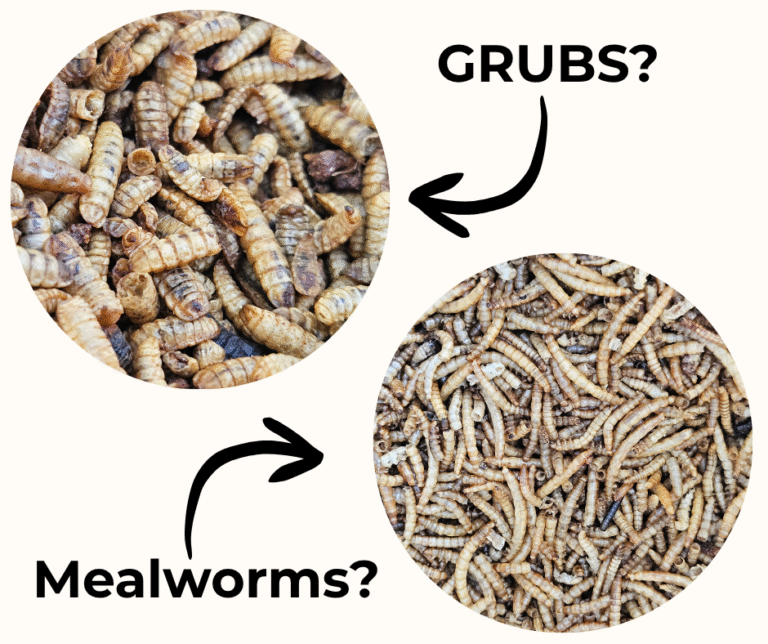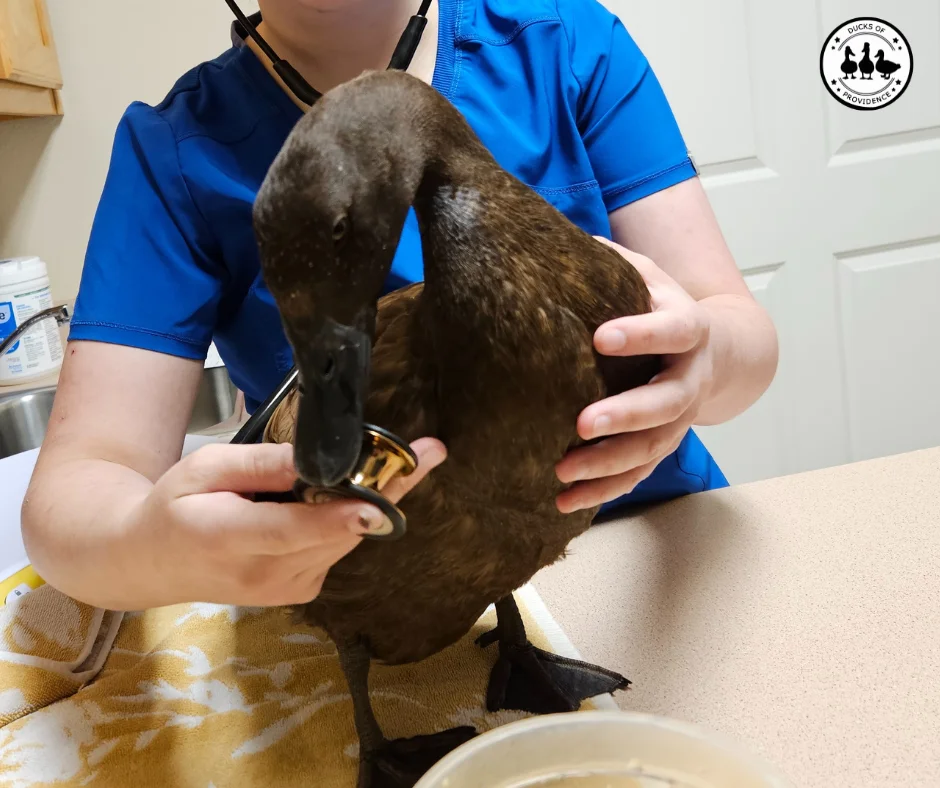
How to Conduct a Duck Health Check: A Comprehensive Guide
Last updated on June 21st, 2025 at 03:27 pm
Welcome to the essential guide on duck health and care. Whether you’re a seasoned duck keeper or just starting out, understanding how to monitor and maintain your ducks’ health is crucial for their well-being. Ducks are delightful and unique companions, each with their own personality and specific needs. This guide aims to provide comprehensive insights into conducting thorough health checks, addressing common health issues, and promoting optimal care practices.
From assessing their eyes to checking their feet, feathers, and beyond, we’ll explore every aspect of keeping your ducks healthy and happy. We’ll cover practical tips on handling, weighing, and monitoring their condition, as well as recognizing signs of illness and when to seek veterinary care. Whether you’re looking to enhance your current practices or start fresh with a new flock, this guide will empower you to provide the best possible care for your feathered friends.
Join us on this quacking adventure into the world of duck health and care, where we celebrate the joys and challenges of nurturing these charming creatures. Let’s dive in and ensure our ducks thrive in every way possible!
Ducks of Providence is free, thanks to reader support! Ads and affiliate links help us cover costs—if you shop through our links, we may earn a small commission at no extra cost to you. Thanks for helping keep our content free and our ducks happy! 🦆 Learn more
Why Regular Health Checks are Important
Just like us, ducks can experience health issues that need attention. Regular health checks help you catch potential problems early, ensuring your ducks receive timely care. Plus, they offer a wonderful bonding opportunity, allowing you to become more attuned to each duck’s normal behavior and appearance.
What You’ll Need
Before starting your health check, gather these items:
- Clean towel
- Gloves (optional, but helpful for handling)
- Flashlight or headlamp
- A small notebook or health log
- Scale
- Treats (to reward your ducks afterward)
Observation: The First Step
We recommend conducting duck health checks in the morning before they have access to pools or ponds whenever possible. This way, you can catch issues like fecal matting under the vent or ocular discharge that might be cleaned off during swimming or bathing.
Before starting the actual health check, observe the ducks without restraining them. Note their behavior, activity level, general appearance, posture, and movement. Our guide explains more about what constitutes “normal” versus potentially concerning observations.
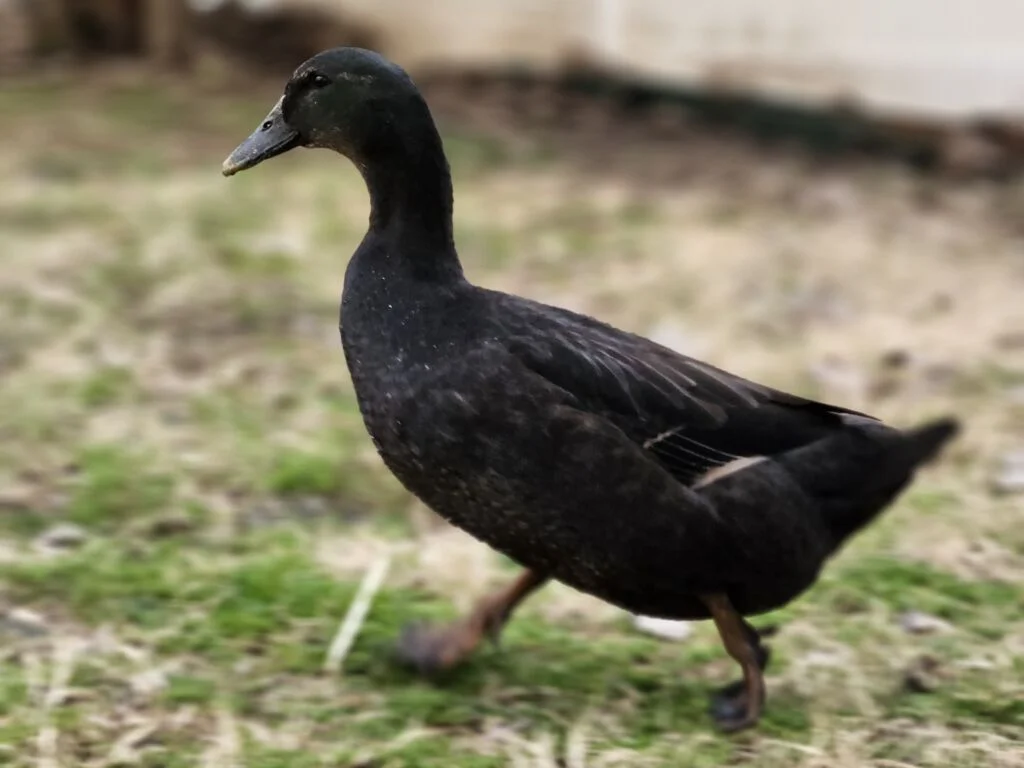
During health checks, your goal is to examine every inch of the duck. Following a general routine helps ensure you don’t miss anything. Develop a system that works for you, but remember that some areas naturally flow into others. Instead of viewing the process as a linear checklist, think of it as a choreographed routine where checking one area leads smoothly into checking another. This approach helps ensure you don’t miss important details in the transition areas.
Throughout the health check, monitor the duck’s breathing and take breaks if they seem overly stressed.
Watch your ducks from a distance. Are they active and moving normally? Any limping or unusual behavior could indicate a problem.
Behavioral Signs
Begin by observing your duck’s behavior. A healthy duck should be:
- Alert
- Active
- Responsive
Be on the lookout for signs of lethargy, unusual aggression, or lack of coordination, which can indicate health problems.
Movement
Watch how your duck walks and swims. Normal movement is smooth and coordinated. Limping, difficulty moving, or imbalance can signal issues that need attention.
Safe Restraint
Before conducting a health check, it’s crucial to know how to safely hold a duck. If possible, having an extra person to help with restraining the duck while you perform the health check can be very beneficial, especially for beginners or when dealing with a particularly nippy duck.
It’s important to be very mindful of the duck’s stress levels and breathing during handling. Having an additional person focused solely on restraint allows for close monitoring of the duck’s condition. If a duck appears very distressed, is breathing heavily (particularly with an open mouth), or seems unable to breathe comfortably, take a break and let them calm down. When setting a duck down, always do so carefully, ensuring their feet are firmly on the ground before letting go.
Physical Examination: A Closer Look
These detailed subsections provide a comprehensive approach to conducting a thorough health check of your ducks, focusing on key areas that can indicate their overall health and well-being.
Eyes
Gently hold your duck and look at their eyes. Check the eyes for clarity and brightness. Healthy eyes are free of discharge and appear alert. Cloudiness or redness could be signs of infection or injury.
- Clarity and Brightness: Check for clarity and brightness. Healthy eyes should appear clear and bright, indicating good overall health.
- Discharge: Inspect for any signs of discharge. Healthy eyes are typically free of discharge, which can indicate infection or injury if present.
- Cloudiness or Redness: Note any cloudiness or redness in the eyes, as these may be signs of underlying health issues such as infections or injuries.
Read here how to treat and manage eye infections in ducks.
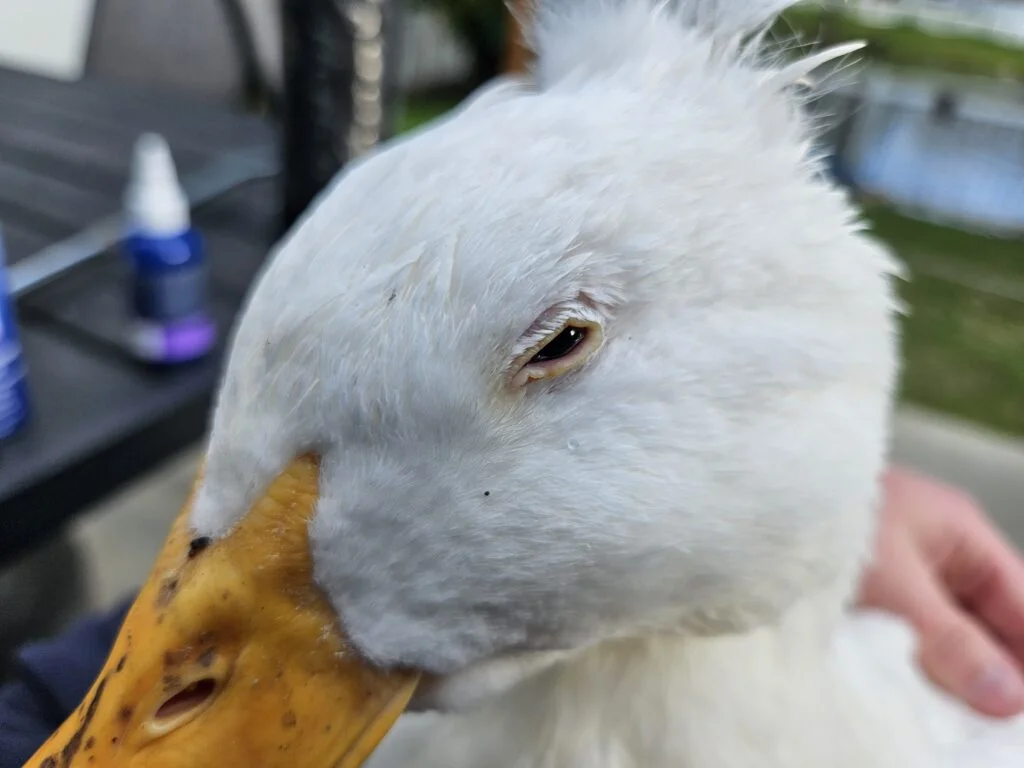
Checking the Ears
Inspecting a duck’s ears during a health check is important to ensure their overall well-being. Gently lift the feathers around the duck’s ears to expose them. Use a flashlight if necessary to get a clear view inside the ear canal. You should also observe the duck for signs of discomfort, such as shaking its head or scratching its ears. Yu should look for:
- Cleanliness: The ears should appear clean without any discharge or excessive wax buildup.
- Redness or Irritation: Check for any signs of redness, swelling, or irritation around the ear canal.
- Foreign Objects: Look for any signs of foreign objects or pests like mites that could be causing discomfort.
Regular ear checks contribute to maintaining your duck’s health and ensuring they remain comfortable and free from ear-related problems.
Nares (Nostrils)
Inspecting the nares (nostrils) involves:
- Clear Passage: Ensure the nares are clear and free from any obstruction or discharge, which could indicate respiratory issues or nasal infections.
- Blocked or Runny Nares: Note any signs of blockage or runniness in the nares, as these symptoms may point to respiratory problems requiring attention.
Duck Bill
- Inspecting the Bill: Check the duck’s bill for any injuries or abrasions, as it is much softer compared to a chicken’s beak and can be easily damaged.
- Smoothness: Check the bill for smooth texture, free of cracks, rough patches, or deformities, which could affect eating and preening abilities.
- Handle with Care: Exercise caution when evaluating the bill; avoid peeling or picking at it to prevent causing further injury.
- Comparative Note: Unlike chicken beaks, which are harder and more resilient, a duck’s bill requires gentle handling during examination to ensure their well-being.
Inside the Duck Mouth
- Moisture and Mucus: Inside the mouth should be moist without excessive mucus buildup, indicating normal hydration and health.
- Ulcers and Lesions: Check for ulcers, lesions, or areas of discoloration, which could indicate oral health issues or injuries.
- Papillae: Waterfowl have small bumps (papillae) on the roof of the mouth and along the sides of the tongue; note any unusual lumps or asymmetry.
- Breath Odor: Normal breath should not have an overly strong odor; a sour smell could indicate a sour crop or other digestive issues.
- Glottis: Locate the glottis (opening to the trachea) at the center of the back of the throat. If the tongue obstructs the view, gently push it down to observe the glottis opening and closing smoothly during quiet breathing.
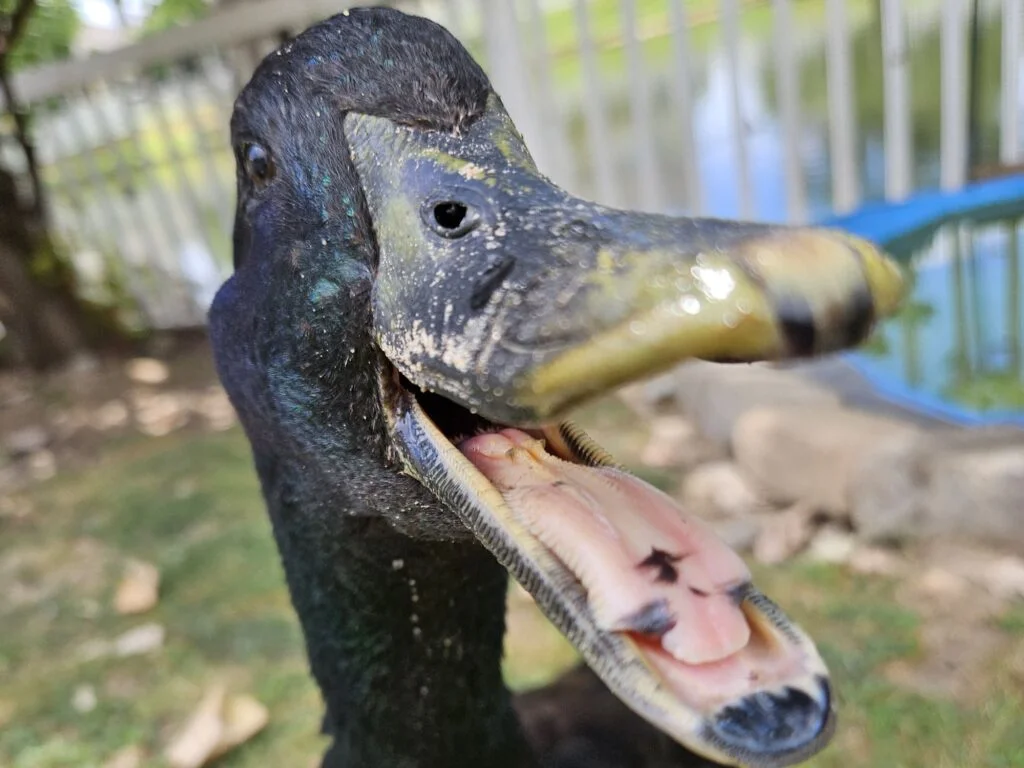
Head and Neck
- Head Position and Wry Neck: Observe the position of the duck’s head; any head tilting, commonly known as wry neck, should be noted. While ducks naturally adjust their head position depending on their activities, persistent tilting or inability to hold the neck upright could indicate wry neck, a condition that may be caused by injury or illness.
- Neck Alignment: Ducks should be able to hold their neck upright, extending vertically from their body. Drooping or inability to extend the neck normally may signal illness or injury.
- Physical Examination: Feel along the neck for any unusual lumps or lesions, which could indicate underlying health concerns.
- Comparison with Galliformes: Unlike galliformes (e.g., chickens, turkeys), ducks do not possess a true crop. However, their esophagus can expand to accommodate food intake. Despite this, be vigilant for signs of distention or other crop-like issues in waterfowl.
- Attention to Distention: Gently palpate around the base of the neck and observe for any signs of abnormal swelling or distention, which may warrant further investigation or veterinary attention.
Wings
Carefully observe the duck’s wings, taking precautions to prevent them from flapping freely, which could cause injury to themselves or to the handler.
- Position and Symmetry: The wings should be held close to the body and generally symmetrical. Check for normal movement in the wing joints when flexed and extended.
- Signs of Injury: A droopy wing could indicate a fracture or weakness. Twisting outward of the wing is known as angel wing, which should be addressed early with veterinary consultation for potential correction.
- Monitoring Wing Health: Regularly check for swelling, heat, abrasions, or other injuries on the wings. Scabby wing tips or tattered feathers may indicate mobility issues where the wings are used for balance and support.
- Environmental Considerations: Investigate any wing abrasions that could result from elements in their environment, such as hardware cloth. Adjust the living space as necessary to prevent further injury.
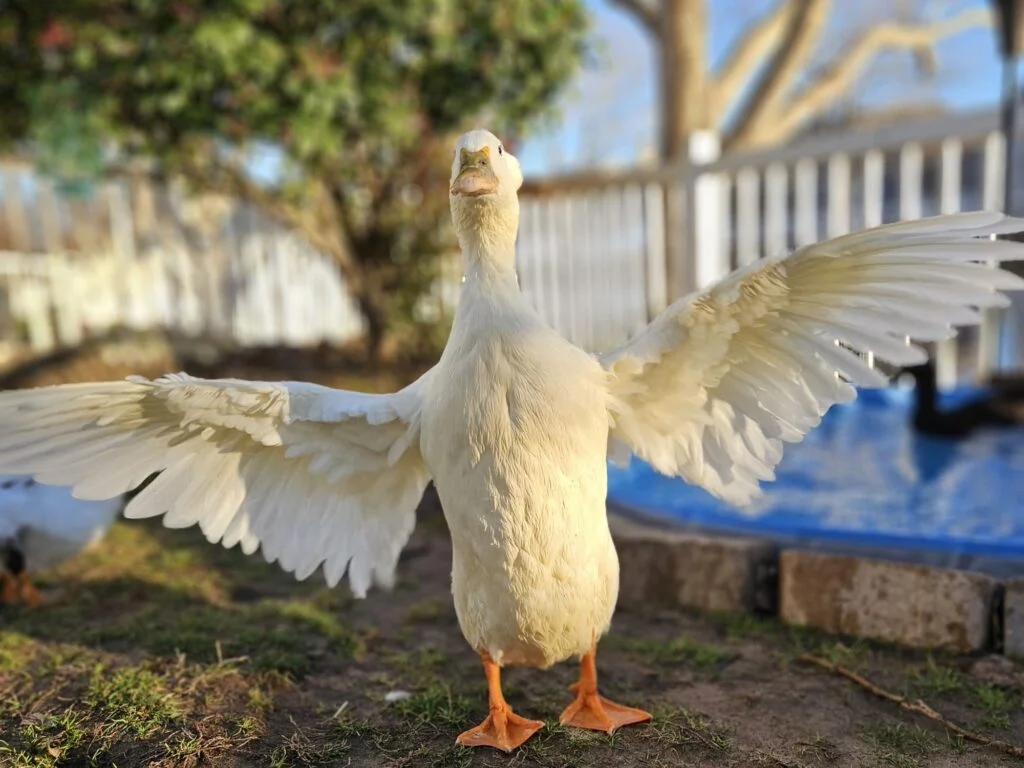
Feathers
When assessing your duck’s feathers, look for:
- Gloss and Alignment: Observe the feathers for glossiness and proper alignment, which are indicators of good feather health and maintenance.
- Lumps, Bumps, or Missing Feathers: Feel for any abnormal lumps, bumps, or areas where feathers are missing, which could suggest injuries, parasites, or health issues.
- Cleanliness: Check for cleanliness of feathers, as soiling or debris could indicate poor grooming habits or environmental factors affecting the duck’s health.
Checking the Preen Gland
The preen gland, also known as the uropygial gland, is located at the base of a duck’s tail. This gland produces oils that ducks use to maintain the health and waterproofing of their feathers. During your health check, it’s important to examine this gland to ensure it’s functioning properly. Look for:
- Normal Discharge: Orange-tinged oily discharge from the tip of the preen gland and on the feathers is normal and indicates healthy gland function.
- Symmetry and Lumps: The gland should be symmetrical without additional lumps, aside from its lobes.
- Abnormalities: Any signs of inflammation, absence of oily discharge, scabbing, wounds, or other abnormalities in this area should be promptly discussed with your veterinarian for evaluation and treatment.
Skin and Feet
Gently part the feathers to check the skin. Examine the skin for lesions, swelling, or discoloration. Healthy skin is smooth and free of abnormal growths.
- Skin Examination: Gently part the feathers to examine the skin for lesions, abrasions, swelling, or discoloration, which may indicate infections or injuries.
- Feet Condition: Check the feet for cuts, sores, swelling, or signs of bumblefoot, ensuring the webbing is intact and healthy.
- Abnormal Growths: Look for any abnormal growths or tumors on the skin that require veterinary attention for proper diagnosis and treatment.
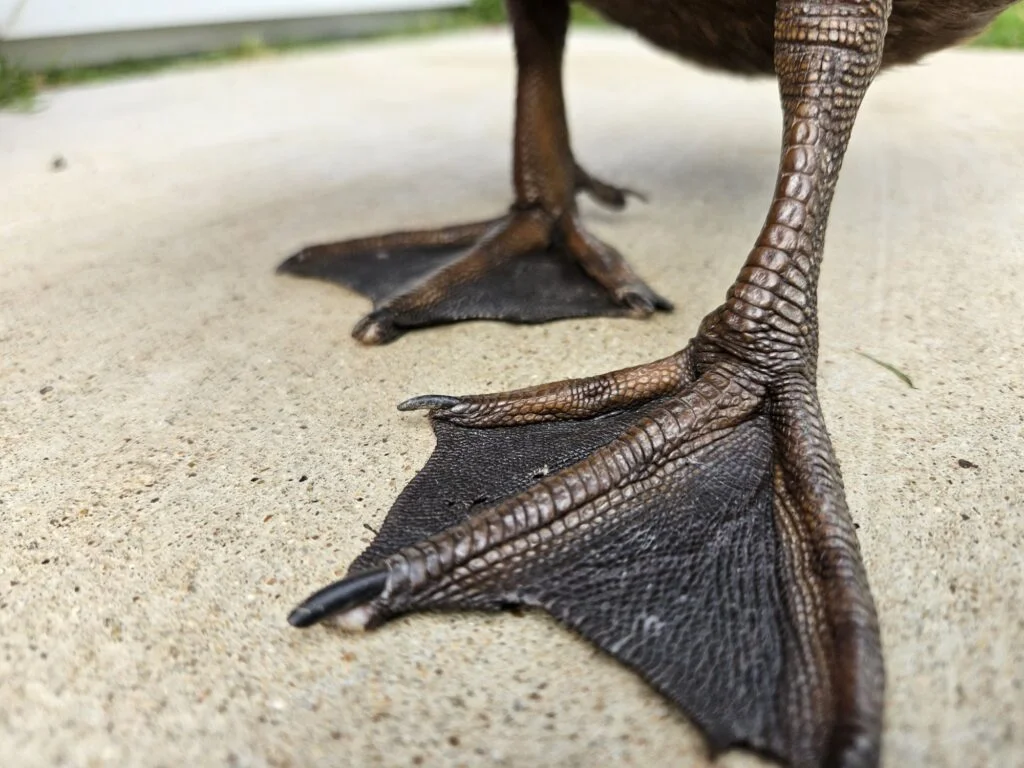
Checking your Duck’s Legs:
- Heat and Swelling: Feel the legs for any heat or swelling, which can indicate inflammation or injury that requires prompt veterinary assessment.
- Hocks Examination: Pay special attention to the hocks for signs of pressure sores, especially in heavier breeds or ducks with mobility issues, ensuring early detection and intervention.
- Range of Motion: Evaluate the duck’s range of motion in the legs, particularly the hocks, for any signs of discomfort, crepitus (crackling or grating sensations), or restricted movement that may suggest joint issues or fractures.
- Joint Health: Monitor the health of the joints, including the knees and hips, which are critical for mobility and overall health, noting any pain, resistance, or abnormalities that may require veterinary attention.
Body Condition
Gently feel along the keel bone (breastbone). A layer of muscle should cover the bone. A very prominent keel bone may suggest undernourishment. A healthy duck will have a balanced and well-muscled body.
- Body Types: Different breeds of ducks exhibit varying body types, influencing their overall health and appearance. Consider these differences throughout the health check.
- Breast and Keel Assessment: Pay special attention to the breast and keel (breastbone or sternum) while assessing body condition. There should be distinct muscle on either side of the keel bone.
- Underweight Signs: A prominent keel bone often indicates the duck is underweight, requiring attention to their diet and overall health.
- Obesity Indicators: Difficulty feeling the keel bone through muscle and fat may suggest obesity, necessitating dietary adjustments and increased activity.
- Keel Sores: Check along the keel for any sores, which should be treated promptly to prevent infection. Investigate potential causes such as mobility issues or prolonged periods of lying down.
Monitoring and addressing these factors contribute to maintaining optimal body condition and overall health in ducks of different breeds.
Checking the Abdomen
When conducting a health check, examining a duck’s abdomen is crucial for detecting potential health issues. Here’s what to look for and how to proceed:
- Normal Size and Feel: A healthy duck’s abdomen should feel soft and relatively small. Note any changes in size or firmness.
- Egg-Laying Considerations: Female ducks may have a more distended abdomen during egg-laying seasons. Be cautious to avoid disturbing any fully shelled eggs in their oviduct.
- Signs of Distress: Watch for signs like distension, fluid buildup, or the presence of hard structures within the abdomen, which could indicate reproductive issues or other health concerns.
Cloaca and Vent Examination
A duck’s vent is the external opening of the cloaca, located just below the tail. It is where waste and eggs are released.
- Cloaca Health: Ensure the cloaca is clean, tight, and matches the surrounding skin color without discharge, fecal buildup, or irritation. A healthy cloaca appears pink and moist.
- Abnormalities: Check for wounds, signs of parasites, or prolapsed tissue, which can indicate underlying health issues requiring immediate attention.
- Prolapse: Watch for any signs of prolapse, such as internal tissue protruding from the cloaca. Prolapse is a serious condition that needs prompt veterinary care.
- Vent Feathers: Inspect the feathers around the vent for cleanliness. Dirty or matted feathers may indicate digestive issues like diarrhea.
- Hygiene Check: Look for poop around the vent area, as its presence can signal poor health or hygiene practices.
- Healthy Feathers: Healthy vent feathers should be dry and intact, contributing to overall cleanliness and well-being.
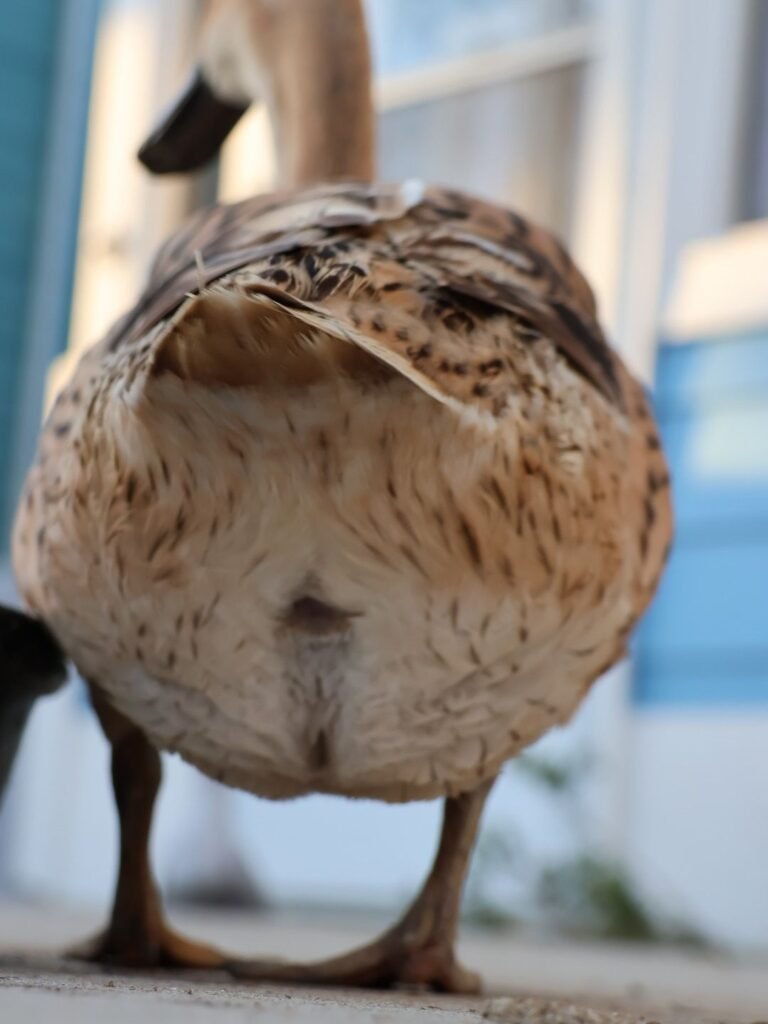
Checking Vital Signs
Breathing
Listen to the duck’s breathing. It should be steady and quiet. Wheezing, gurgling, or clicking sounds can indicate respiratory issues. Normal breathing is calm and rhythmic.
Heart Rate
Feel the chest for the heart rate. An excessively rapid or irregular heartbeat may be a sign of underlying health problems. A healthy duck has a strong and regular heartbeat.
Duck Vitals
- Heart Rate: 130-230 bpm
- Respiratory Rate: 13-40 bpm
- Body Temperature: 102-106 F
Weight Monitoring
Monitor your duck’s weight and eating habits. Regularly weigh your duck to detect significant weight changes, which can be a sign of health issues. Sudden weight loss or gain warrants further investigation. A healthy duck maintains a stable weight appropriate for its species and age.
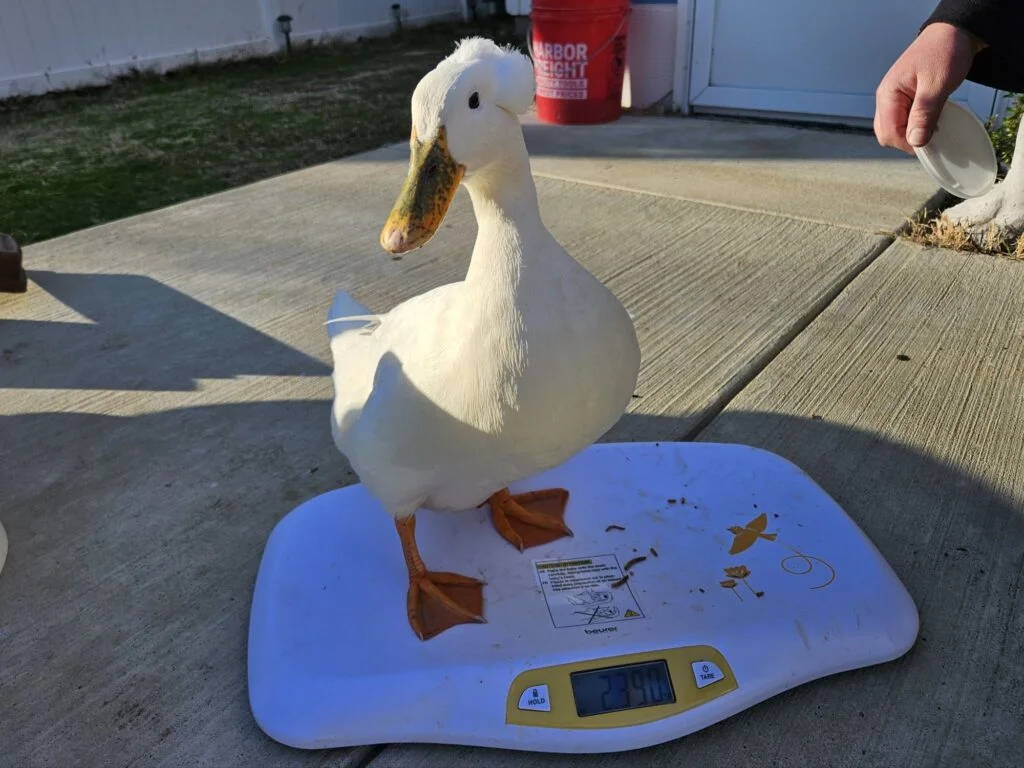
Accurate weight monitoring is crucial for duck health, indicating consistency and detecting changes that may signal illness, malnutrition, or parasites.
- Weight Loss: Significant weight loss warrants veterinary attention to diagnose and address underlying health issues promptly.
- Weight Gain: Avoid overfeeding and inappropriate diets to prevent obesity, which can lead to secondary health problems like arthritis or bumblefoot.
- Weighing Methods: Use scales designed for dynamic weighing or baby scales with a hold feature for accurate measurements. A deep basket on a flat platform scale is effective, ensuring to zero out or adjust for basket weight if necessary.
- Safety During Weighing: Provide traction on the scale surface (e.g., with a bath mat) and ensure close supervision to prevent slipping or injury, especially for larger ducks or those with specific health concerns.
- Body Condition Evaluation: Assess body condition alongside weight to determine overall health and adjust care accordingly, considering veterinary guidance on body condition scoring for accurate assessment.
- Comprehensive Health Monitoring: While weight is important, evaluating both weight and body condition provides a more comprehensive understanding of health status, particularly in cases where weight alone may not reflect underlying health issues like reproductive problems.
Monitoring weight and body condition together helps ensure the well-being of duck residents, allowing early intervention and tailored care as needed.
Check Their Poop
Observe the droppings for changes in color, consistency, and frequency. Normal droppings are firm and well-formed. Abnormal droppings can indicate digestive problems.
- Monitoring Droppings: Note any changes in stool appearance during the health check, distinguishing between normal and potentially concerning droppings.
- Immediate Concerns: Contact your veterinarian promptly if you observe bloody stool, worms, consistently foamy, loose, or unusually colored stool unrelated to diet, or watery stool accompanied by signs of illness.
- Fecal Sample: When unsure, collect a fecal sample and consult your veterinarian for further evaluation and guidance.
Parasite Check
External Parasites: Inspect the duck for lice, mites, or fleas, especially around the base of feathers and in warm, dark areas. Healthy ducks have clean, parasite-free skin and feathers.
Internal Parasites: Regular fecal examinations are crucial to detect internal parasites. Consult a vet for guidance on how to perform these checks. Observing the droppings for any signs of parasites is also essential.
Nutritional Assessment
Ensure your duck is eating a balanced diet appropriate for its age and species. Inspect the feeding area to ensure food is clean and accessible. A healthy diet supports vibrant feathers and steady weight.
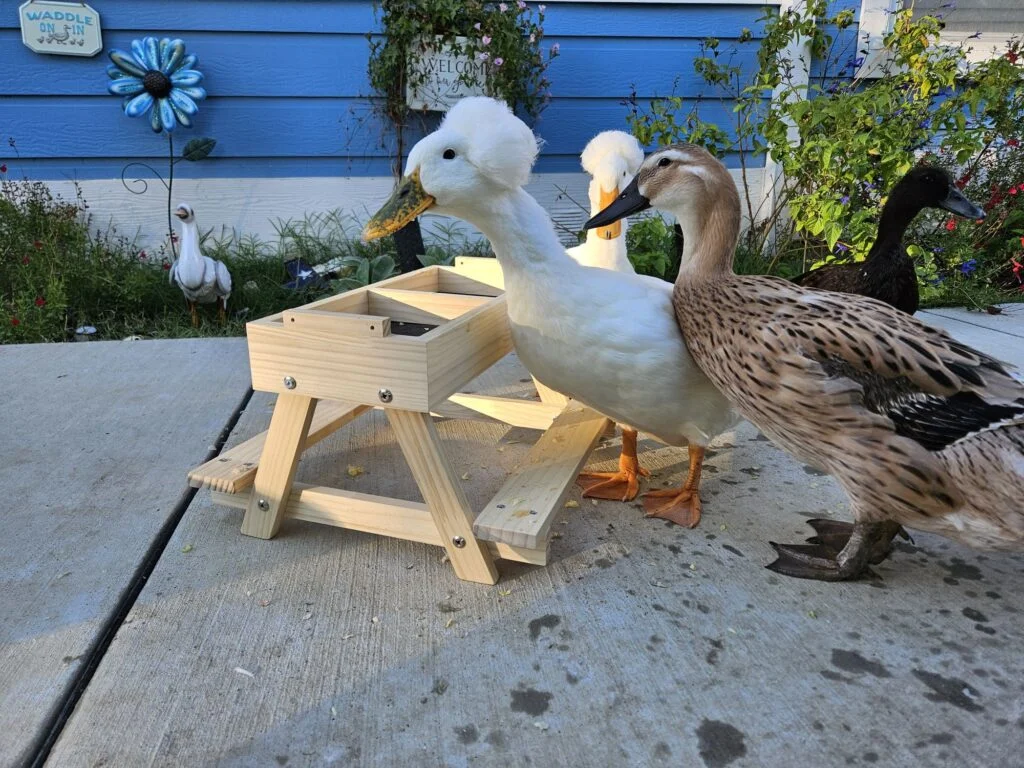
Keeping Records
Maintain a health log for each duck. Note any changes in behavior, weight, or physical condition. This record will be invaluable for tracking their health over time and providing detailed information to your vet if needed.
How Often to Conduct Health Checks
Regular health checks should be performed at least once a month. More frequent checks may be necessary if you notice any potential health issues or if your duck is recovering from an illness.

Pet Duck Guide
This is the BEST book about ducks I have ever had. I can highly recommend it to every duck owner, new or experienced. It is very comprehensive, with pictures and illustrations. It covers all topics related to duck care and keeping ducks. It even has multiple case studies.
Isolate Your Duck If necessary
If you notice a duck showing signs of illness, consulting a veterinarian is essential for accurate diagnosis and treatment. Depending on the nature of the illness, isolating the affected duck may be necessary to prevent potential spread to the rest of the flock. However, other ducks might have already been exposed in cases where symptoms have already appeared. This situation requires careful consideration of what is best for the overall health of the flock.
Isolating a sick duck can lead to increased stress, which may hinder recovery. Yet, separation may be necessary if the duck is being bullied, struggling to compete for food, or requires closer monitoring of their health and habits. In such cases, keeping the duck in a quiet area with a close companion can be a beneficial temporary measure. This allows for careful observation and ensures they receive adequate care until they are ready to rejoin the flock, following veterinary approval.

First Aid Kit for your Ducks
During your check-ups, you might discover minor injuries or signs of illness that need immediate attention. For instance, you might find a small cut on a duck’s foot or notice signs of bumblefoot. With a well-stocked first aid kit, you can promptly clean the wound, apply antiseptic, and bandage it to prevent infection and promote healing.
Regular health checks also help you spot early signs of common issues like bumblefoot or eye infections. Having items like tweezers, ointment, and bandages readily available means you can address these problems immediately, preventing them from becoming more serious.

By integrating a first aid kit into your health check routine, you’re not only prepared for emergencies but also ensuring that minor health issues are managed promptly and effectively. This proactive approach keeps your ducks healthy and happy, allowing them to thrive under your care. Regular health checks combined with a ready-to-use first aid kit are key components of responsible duck keeping.
When to Seek Veterinary Help
If you notice any abnormalities during the health check, it’s essential to consult a veterinarian experienced in avian medicine. Regular health checks, ideally monthly, help catch potential issues early, ensuring your duck remains healthy and happy.
Wrapping Up
After the health check, reward your ducks with their favorite treats and some extra attention. Regular health checks are a proactive way to ensure your ducks live long, happy lives. Remember, a healthy duck is a happy duck!
Have you conducted a health check on your ducks recently? Share your experiences and any tips you have in the comments below. Let’s keep our flocks healthy together!



